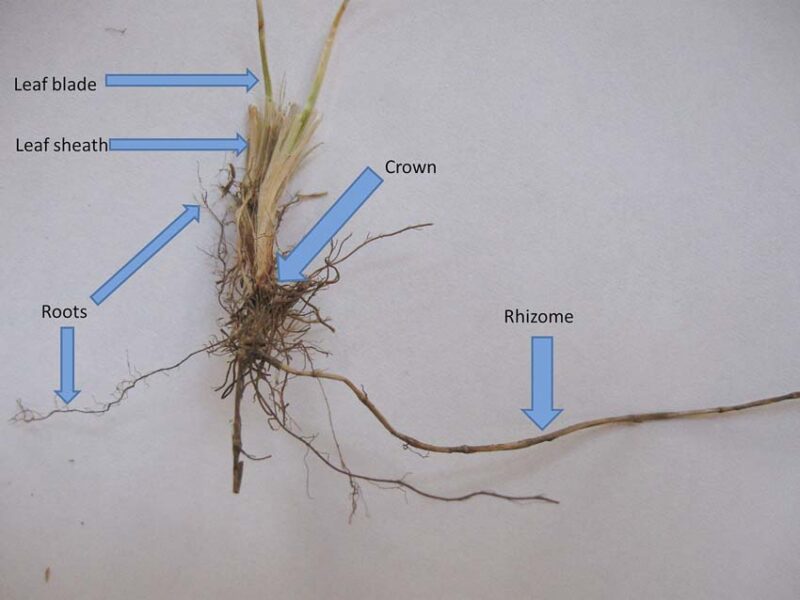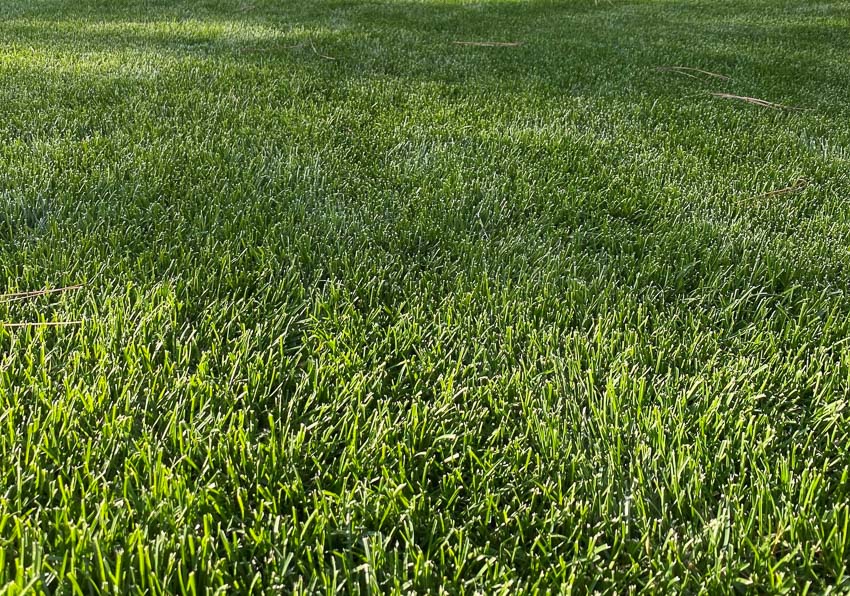There’s a good reason that Kentucky Bluegrass remains a homeowner’s favorite for lawns. This grass has dense, lush, and durable blades — provided it receives the right care. Fortunately, it’s not too hard to give Kentucky bluegrass what it needs, provided you take the right steps. If you give it the right conditions and put the effort into planning, planting, and growing, you too can enjoy a lawn composed of this attractive grass.
Knowing all the key factors about Kentucky Bluegrass is fundamental to achieving the best results for your lawn. Although its name has associations with a U.S. state, this grass actually originated in Europe and Asia.

Once brought stateside, it quickly made a name for itself as one of the premier lawn grasses nationwide. Kentucky Bluegrass identification and planting is easy, once you know what to look for.
Characteristics of Kentucky Bluegrass
Part of the beauty of Kentucky Bluegrass is its color: These range from emerald to deep blue-green. Moreover, due to the medium to fine texture of its blades, Kentucky Bluegrass lawns are also comfortable for bare feet and make it a common choice for home lawns.
Effects of local climate on Kentucky Bluegrass
This grass is a perennial variety, so it grows best in spring and fall, and its blades maintain their vitality over the years. Generally, it favors cool temperatures and thrives in more temperate conditions.
Moreover, out of the common lawn grasses, many consider Kentucky Bluegrass to have the best resistance to cold. For this reason, this type of grass is a frequent choice for many homeowners in northern areas because it prefers mild summers and shrugs off cold winters.
One important characteristic of Kentucky Bluegrass is its growth habits.

Kentucky Bluegrass slows radically in hot weather. In fact, the grass will go dormant in extreme heat or drought conditions. However, its robust nature means that this grass quickly bounces back once it receives appropriate irrigation.
Unlike other grass species, this type has shallow roots. This is another reason why it is not a wise choice for hotter, drier parts of the country. Kentucky Bluegrass thrives in areas where temperatures don’t go over 75F in July.
Nevertheless, determined homeowners in warmer states can achieve lush results despite the climate, if they keep a strong irrigation system in place. Regular and robust irrigation promotes deep root growth and greater grass longevity.
Planting Kentucky Bluegrass
One of the benefits of this grass is that it quickly germinates from the seed stage. That means you can plant this grass from seed. However, this process can be somewhat slower than other grasses.
Some grow at three times the speed of Kentucky Bluegrass. Once it starts growing though, it is a self-spreading grass.

It creates rhizomes underground that spread out and eventually grow into a beautiful, thick turf. Because of the vigorous growth pattern, Kentucky Bluegrass is resilient.
Don’t want to wait to get your new Kentucky Bluegrass lawn? Learn about the cost of installing sod.
Gardening products that promote growth
There are a number of treatments you can add to your lawn to encourage growth and optimize growing conditions.
Kentucky Bluegrass requires a hefty amount of irrigation to grow to its full, dense potential. There are some products on the market that improve water retention and resilience.
After adding these fertilizers to the grass, the seeds will require up to 30% less water than they would without the product. This results in cheaper lawn maintenance and stronger, denser grass.

Another important product to consider adding to your Kentucky Bluegrass care plan is a reliable chemical weed remover. The persistent nature of weeds leads to them popping up where they shouldn’t. Thus, it makes sense to choose a good herbicide to avoid unattractive additions to your lawn.
In the same vein, there are specific products to prevent insect damage.
But there are homeowners who worry about adding chemicals to their lawn for fear that it will harm it. Fortunately, organic weedkillers are an option.
Chemical or organic is a choice for the individual gardener. Ultimately, your lawn will thrive provided you carefully research the right type and dosage of fertilizer for your needs.
The Kentucky Bluegrass Care Calendar
Taking its maintenance requirements into account, Kentucky Bluegrass needs specific action at specific times of the year that other grass types may not require. To make things simpler, here is an overview of the care calendar for optimum results when growing Kentucky Bluegrass.
Once you are familiar with this identification and planting care plan, you should find it easier to maintain.
Generally, the best time to work on this is between spring and fall. However, the precise schedule depends on the geographic conditions where you grow your Kentucky Bluegrass.
Your watering schedule will change, depending on how hot and dry your area is.
March to May
The first months after winter are ideal to start prepping and maintaining your lawn. The warmer days and cold nights promote grass growth.
Solid preparation includes mowing it at a height of approximately 2 to 2.5 inches during the cooler months. Lawn care at this time also includes weeding and adding products to avoid the reemergence of unsightly shoots.
Additionally, the cooler weather promotes rapid germination with Kentucky Blue Grass. As a result, spring is an excellent time to seed, overseed, and fix any bare patches that have appeared in the lawn during the winter months.

Overseeding is the practice of adding seeds to existing turf to advance further growth and avoid patches in the lawn.
During this time of year, you should aim to have a weekly watering schedule in place where your lawn gets at least an inch of water weekly. In warmer areas, it should receive a little more.
June to August
The summer months bring hotter weather, and along with it different care needs for your Kentucky Bluegrass. At this time, you should mow your grass at 4 inches or so, while adding more fertilizer to maintain its unique color.
Furthermore, the optimal soil PH levels for this type of grass range between 5 and 7. Anything outside this range will result in pale grass. Careful monitoring of the soil and corrective treatment if necessary is fundamental before the cooler months kick in.
Your watering schedule will also change to ensure your lawn gets at least two inches of water weekly.
Finally, this is the time when bugs flock to your lawn, so you’ll need to treat the grass accordingly for pests both under and above ground.
September to November
While the days remain relatively warm, fall brings colder nights. Your Kentucky Bluegrass will soon stop growing.
Mow to about 2-2.5 inches. Once your lawn goes dormant, you shouldn’t need to mow it anymore.
Preparation for winter includes protecting your lawn against the potential frosts and spot weeds.
If you plan on overseeding your lawn, you should aim to do so around 45 days before the first expected frosts. Doing this too close to frost season can have damaging results, causing the death of many new seedlings.
Your watering schedule will also go down to just an inch every 10-14 days.
And due to its rapid growth potential, thatch is a dangerous possibility when growing a Kentucky Bluegrass lawn. Indeed, in order to properly care for your lawn, you will need to consider adding a dethatching and aeration phase to your care plan.
Finally, regular leaf raking is essential to keep your lawn in optimal condition.
December to February
Throughout this period of cool weather, your grass is dormant, so there’s not much growth going on. Therefore, any work you do at this time is preparation for the spring.
One task is to make sure that your lawn is getting the sunlight it needs. Regularly check your lawn for anything that shouldn’t be there. This includes removing leaves, sticks, and rocks.

Closer to the spring, you should flush out the lawn to remove any traces of pet urine, salt from defrosting, or other potential contaminants.
Takeaways for Kentucky Bluegrass care
With its attractive color and texture, Kentucky Bluegrass gives both home and commercial lawns a pleasant look. Furthermore, it is a sturdy, all-purpose grass.
Planting and care can be a little more demanding than other varieties, but this certainly hasn’t injured its national popularity. What’s more, following the proper maintenance schedule in this guide makes things a lot easier.



